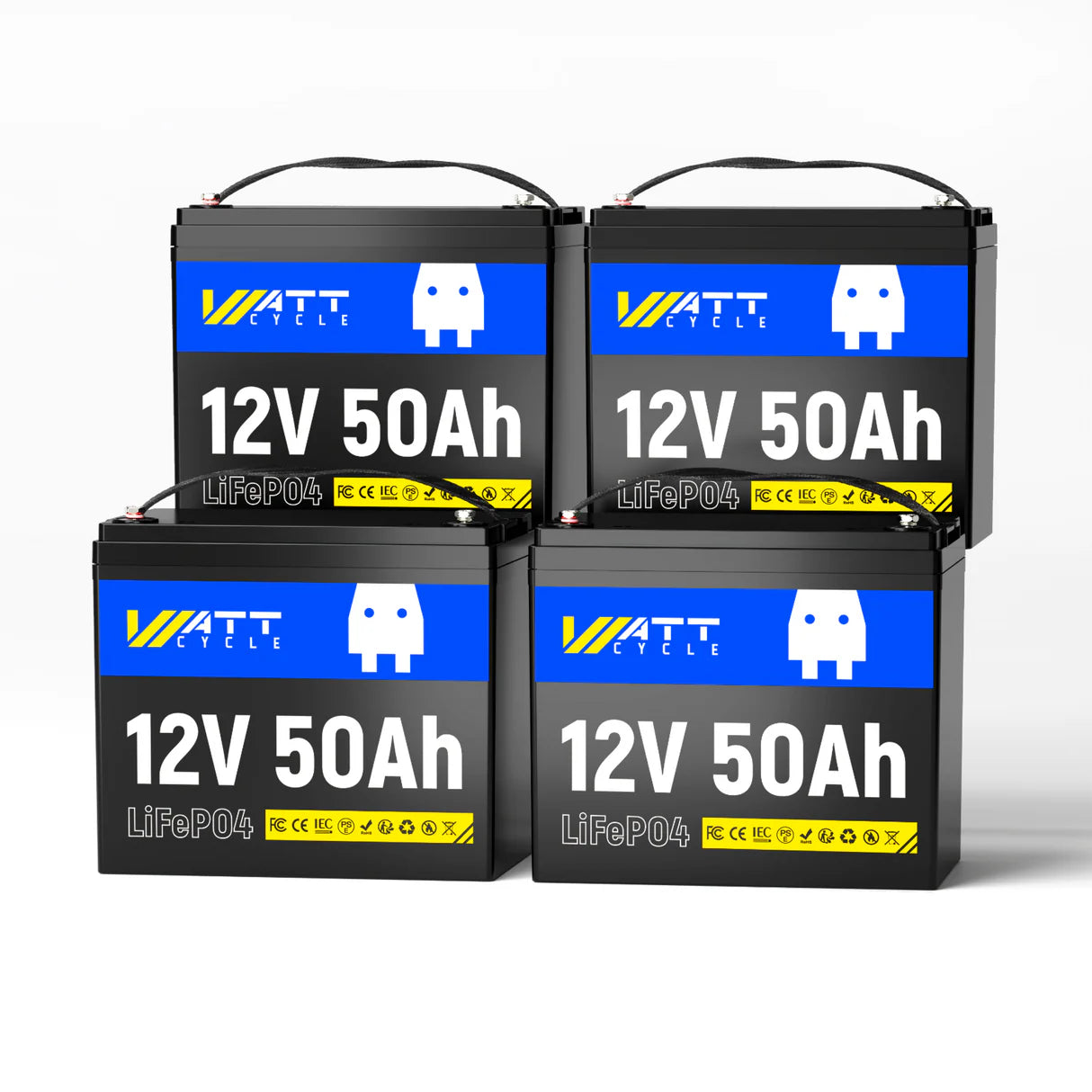











What's inside the box?
Know Every Part of the Battery
Main Features Summary
-

General
Dimensions:L19.5 x W13.0 x H17.0
Weight: 11.46lbs(5.2kg)
Waterproof Rating: IP65
Housing Material: ABS (Flame Retardant Plastic)
Terminal: M8 bolts
-

Battery
Cell: Grade A+ LiFePO4 Cells
Energy: 640WhCycle Life: 5,000 cycles @100% DOD ~ 15,000 cycles @60% DOD
Max. Expansion: 4S4P
Internal Resistance: ≤40mΩ
-

BMS: 50A
Max. Cont. Output Power:640W
Max. Cont. Charge/Discharge Current: 50A
Max. Discharge Current (5s): 100A±50A
Low-temp Protection: Yes (32℉/0℃)
Low-temp Auto Recovery: Yes (41℉/5℃)
-

Charge
Charge Voltage/Current:14.6V ± 0.2V/10A (0.2C)
Charge Method: CC/CV
Charge Temperature: 32℉~131℉ (0℃~50℃)
Discharge Temperature:-4℉~131℉ (-20℃~55℃)
Storage Temperature: 32℉~131℉ (0℃~55℃)
Start Your Trip with the Safe & Reliable Battery
| Dimensions (Inches) | L195 x W130 x H170 mm |
| Weight | 11.4lbs / 5.2kg |
| Waterproof Rating | IP65 |
| Warranty | 5 years |
| Housing Material | ABS (Flame Retardant Plastic) |
| Terminal | M8 bolts |
| Cell | Grade A+ LiFePO4 Cells |
| Nominal Voltage | 12.8V |
| Nominal/Usable Capability | 50Ah |
| Energy | 640Wh |
| Cycle Life | 5,000 cycles @100% DOD, 6,000 cycles @80% DOD, 15,000 cycles @60% DOD |
| Max Depth of Discharge (DOD) | 100% |
| Max. Expansion | 4S4P |
| Internal Resistance | ≤40mΩ |
| BMS | 50A |
| Max. Continuous Output Power | 640W |
| Max. Continuous Charge Current | 50A |
| Max. Continuous Discharge Current | 50A |
| Charge Voltage | 14.6V ± 0.2V |
| Charge Method | CC/CV |
| Recommend Charge Current | 10A (0.2C) |
| Charge Temperature | 0℃ to 50℃ / 32℉ to 131℉ |
| Discharge Temperature: | -20℃ to 55℃ / -4℉ to 131℉ |
| Storage Temperature | 0℃ to 55℃ / 32℉ to 131℉ |
| Low-Temperature Protection | Yes (32℉/0℃) |
| Low-Temperature Charging Protection Auto Recovery | Yes (41℉/5℃) |
Frequently Asked Questions
Q1: Does it support the short circuit protection?
A1:
Yes!
Q2:Does it support communication capability?
A2:
Standard shipping normally takes 3-5 days. Next day shipping is available on all domestic orders (for an additional charge). International shipping times depend on the products and destination (estimated at checkout).
Q3: What to do when receive the battery?
A3:
You need to fully charge the battery.
Note: If you want to connect the batteries in series or parallel, please fully charge the batteries.
Q4: Where can l install it?
A4:
The battery should be installed in a clean, cool, and dry location, away from water, oil, and dirt.
Q5: What tools will I use for the installation?
A5:
1) Proper insulation protection equipment
2) Multimeter, battery cables
3) Battery charger/charge controller
Q6: What preparations, tools, and precautions are necessary for installation?
A6:
Before Installation:
1) Check for visible damage to the battery, including cracks, dents, deformation, and other visible abnormalities.
2) Ensure that the top of the battery and the terminal connections are clean, free of dirt and corrosion, and dry. If any issues are detected with the battery, please contact us for assistance.
3) Do not short-circuit the battery terminals, as doing so may cause a current surge and result in irreversible damage to the system and battery.
4) Before connecting, confirm the polarity to avoid damaging the battery due to polarity reversal.
5) Use a circuit breaker, fuse, or an appropriate-sized circuit breaker designated by a qualified electrician, licensed installer, or regulatory authority to protect all electrical equipment.
Installation Steps:
Step 1: Fully charge the batteries separately.
Step 2: Test the voltage after 15 minutes of standing, which should be greater than 13V.
Step 3: Connect your batteries in series and/or parallel.
Q7: Can I connect the battery with other batteries from other brands?
A7:
No, you cannot.
When connecting batteries in series and parallel, please follow the following rules.
1) Same brand (Due to different BMS settings, do not connect lithium batteries of other brands)
2) Same battery type (LiFePO4) (Do not connect batteries of other types, such as lithium-ion, lead-acid, or other batteries)
3) Same voltage (recommended for fully charged batteries) (12.8V)
4) Same capacity (50Ah)
5) The purchase cycle of the two batteries should not exceed three months.
Q8: What precautions should be taken when using lithium batteries?
A8:
Use a LiFePO4 battery charger with a maximum charging voltage/current of 14.6±0.2V/50A.
The battery is classified as a flammable and explosive item. Please use it with caution.
DON'T:
Avoid mechanical impact/No short-circuit/No crush/No disassemble/No incinerate/No heat above 150°F/No harge above 15V/No immerse the battery in water or fire/No use batteries from other brands or different types of batteries in series/parallel (due to different BMS settings)/No reverse the battery and charger
DO:
Use a torque wrench to tighten bolts not your hands
Keep the battery away from fire, hazardous substances, or materials.
Q9: What should be considered when charging?
A9:
Check if the AC-DC battery charger you are using has a specific lithium charging setting and ensure the following charging requirements are met.
Many battery chargers are designed for lead-acid batteries and may not have suitable settings for lithium batteries.
Charging Tips:
1) Use a 14.6V LiFePO4 battery charger.
2) Recommended charging voltage: 14.4 ~ 14.8V
3) Recommended charging current:
20A - The battery will be fully charged to 100% capacity in approximately 2.5 hours.
50A - The battery will be fully charged to 100% capacity in approximately 1 hour.
Q10: How should batteries be stored?
A10:
We recommend charging the WattCycle Energy battery to 50%. Then, disconnect the battery from the load by removing the negative wire from one battery.
Overall, the battery's capacity loss is less than 3.5% per month at 77°F. However, if stored in extreme environmental conditions, the capacity loss may increase.


















